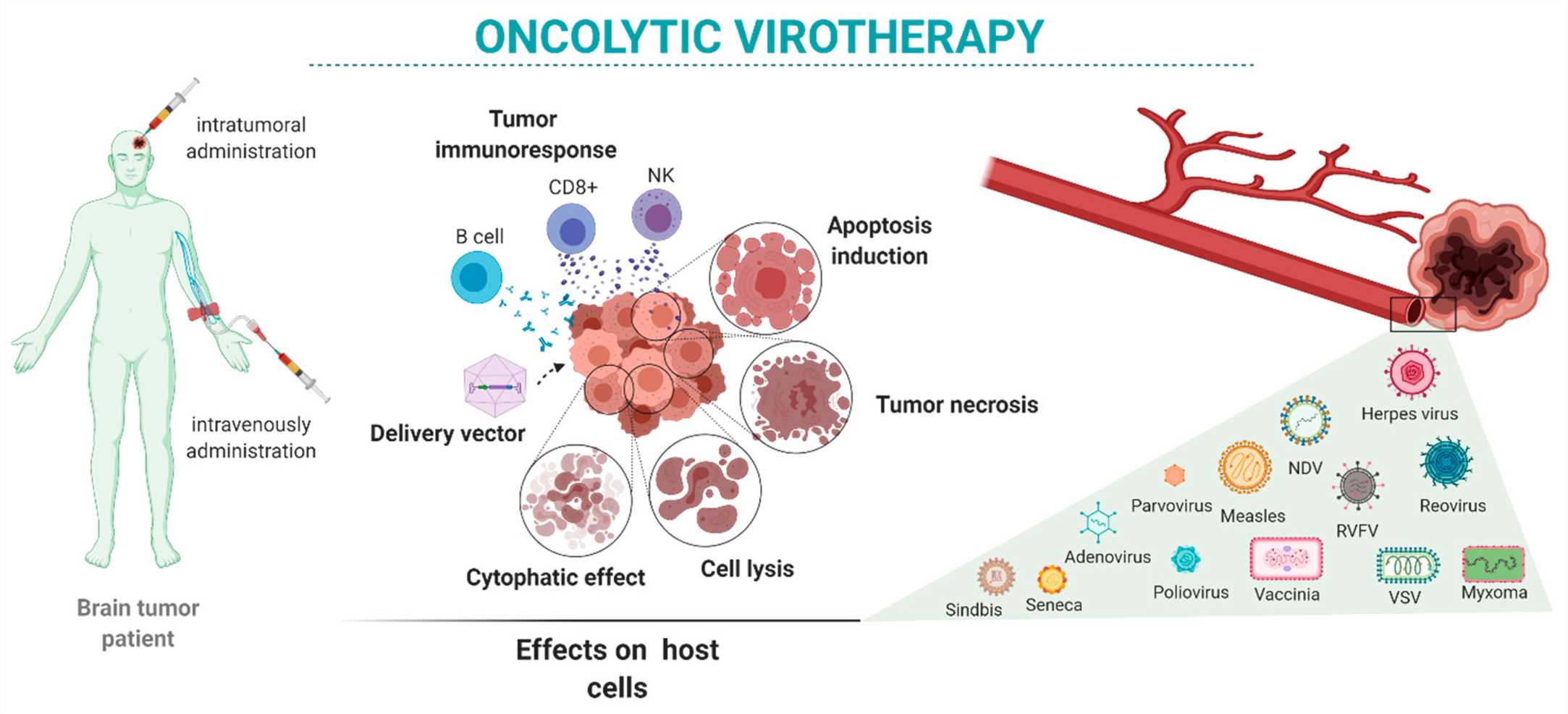Oncolytic Virus based Efficacy Evaluation Service in Mouse Tumor Model
Oncolytic viruses (OVs) are organisms able to infect and lyse the tumor cells while boosting the immune system to help fight the disease. There are currently four OVs approved globally for cancer treatment and many more undergoing clinical development. Clinical trials have evidenced the ability of OVs to kill cancer cells that are resistant to conventional and targeted therapies, providing cancer patients with a much-needed treatment option. Despite having great therapeutic potential, further research into the biology and pharmacology of OVs is required to optimize their tumor selectivity, tolerability and immunogenicity.
 Fig 1. OV therapy for the treatment of brain tumors: administration routes (left), antitumor mechanisms (middle), types and characteristics of viruses (right). (Rius-Rocabert et al. 2020)1, 2
Fig 1. OV therapy for the treatment of brain tumors: administration routes (left), antitumor mechanisms (middle), types and characteristics of viruses (right). (Rius-Rocabert et al. 2020)1, 2
OVs selectively infect and replicate within cancer cells, amplifying themselves and potentially spreading across the tumor. They can also be genetically modified to target tumors. General strategies include deleting genes required for virus replication in healthy cells but nonessential in tumor cells, and incorporating tumor/tissue-specific promoters to critical viral genes. More recently, the combination of OVs and gene therapy present unique opportunities for tumor targeting.
Clinical usage of OVs has been shown to have significant impact on tumor treatment, both in single and combination therapy. As new OVs are discovered and developed, selection of appropriate animal models will be of great importance. Creative Biolabs offers a variety of murine models for OV therapy research, including murine syngeneic, xenograft, and humanized modes.
Our Capabilities that Support OVs Research
Efficacy studies
- Murine syngeneic tumor models
- Suitable to evaluate OV-induced adaptive antitumor immunity.
- Orthotopically transplanted models available for 8 common cancers.
- Murine xenograft tumor models
- A variety of immunodeficient strains available include athymic nude, BALB/c nude, NOD SCID, and nu/nu nude mice.
-
Human cell line-derived xenograft (CDX) models.
a. Subcutaneous model for ease of virus delivery and tumor measurement.
b. Orthotopic model with a more realistic microenvironment.
c. Established human tumor cell lines covering 17 tumor types.
d. Commonly used models validated with standard therapies. - Patient-derived xenograft (PDX) models with greater predictive power.
- Humanized mouse models
- Valuable tools to study OV-induced human immune response.
- Wide therapeutic window for hPBMC model with B2m knockout mice.
- hHSC models are customizable for improved reconstitution of myeloid lineage.
Preclinical functional and safety evaluation
- Overall survival, tumor size change, and response rate.
- Intratumoral virus spread and immune phenotyping of tumor-infiltrated lymphocytes.
Creative Biolabs supports customized solutions that will quickly establish and advance your projects. Contact us to discuss your project in detail today.
You may also be interested in:
ADC Efficacy Evaluation in Mouse Models
CAR-T And CAR-NK Efficacy Evaluation in Mouse Models
Cancer Vaccine Efficacy Evaluation in Mouse Models
References
- Rius-Rocabert S, García-Romero N, García A, Ayuso-Sacido A, Nistal-Villan E. Oncolytic Virotherapy in Glioma Tumors. Int J Mol Sci. 2020;21(20):7604.
- under Open Access license CC BY 4.0, without modification.
For Research Use Only.
